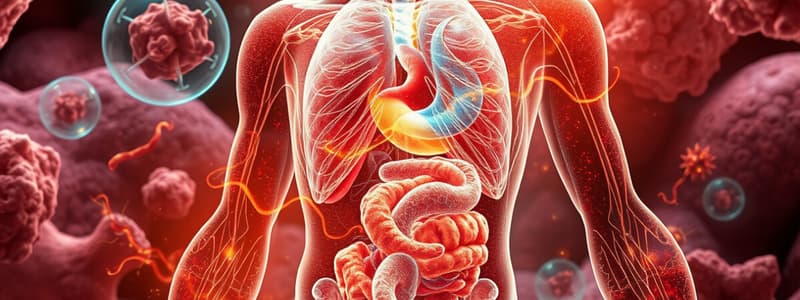Podcast
Questions and Answers
What are the four basic types of tissues in the human body?
What are the four basic types of tissues in the human body?
- Epithelial, Cartilage, Muscle, Bone
- Epithelial, Connective, Muscle, Nervous (correct)
- Epithelial, Muscle, Blood, Nerve
- Connective, Muscle, Skin, Nerve
All cells in the human body have the capability to communicate with other cells.
All cells in the human body have the capability to communicate with other cells.
True (A)
What is the main component of cytoplasm?
What is the main component of cytoplasm?
water
The living substance of the cell is known as _____ .
The living substance of the cell is known as _____ .
What serves as the boundary of the cell?
What serves as the boundary of the cell?
Match the following organelle functions with their descriptions:
Match the following organelle functions with their descriptions:
Cytosol is a part of the organelles found in the cytoplasm.
Cytosol is a part of the organelles found in the cytoplasm.
The system that maintains the shape of cells and their ability to move is known as the _____ .
The system that maintains the shape of cells and their ability to move is known as the _____ .
Flashcards are hidden until you start studying
Study Notes
Cell Organization
- Cells are the basic functional units of all living organisms.
- Tissues consist of similar cells grouped together for a common purpose.
- Four basic tissue types:
- Epithelium
- Connective tissue
- Muscle
- Nervous tissue
- Organs are formed by assembling the four basic tissues.
- Organ systems are collections of organs that perform specific tasks like digestion, reproduction, and respiration.
- The human body contains over 200 different cell types.
Common Characteristics of Cells
- All cells share certain unifying characteristics:
- Surrounded by a bilipid plasma membrane.
- Contain functional organelles.
- Synthesize macromolecules for internal use or export.
- Produce energy.
- Communicate with other cells.
Protoplasm
- Protoplasm is the living substance of the cell, divided into two compartments:
- Cytoplasm
- Karyoplasm
Cytoplasm
- Comprises primarily water and contains various dissolved or suspended inorganic and organic chemicals.
- Cytosol is the fluid part of the cytoplasm, housing organelles.
Cytoskeleton
- Composed of microtubules and microfilaments.
- Functions to maintain cell shape, enable movement, and facilitate intracellular pathways.
Organelles
- Metabolically active structures within the cell, executing specific functions critical for the cell's survival.
Inclusions
- By-products of metabolism, acting as storage forms for:
- Nutrients
- Inert crystals
- Pigments
Membranes
- The cell membrane (or plasma membrane) serves as a boundary, partitioning the cell into compartments such as the nucleus and organelles.
- Composed of a phospholipid bilayer, providing a large surface area for essential biochemical reactions required for life.
Cell Membrane Functions
- Also referred to as plasmalemma, it plays crucial roles in protecting and organizing cellular components.
Studying That Suits You
Use AI to generate personalized quizzes and flashcards to suit your learning preferences.




